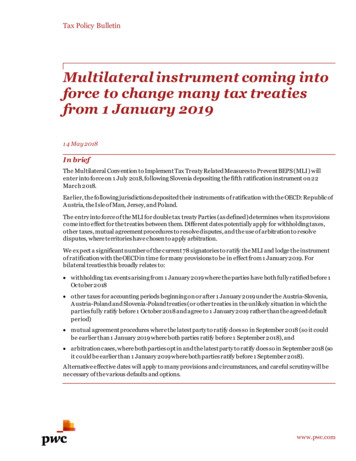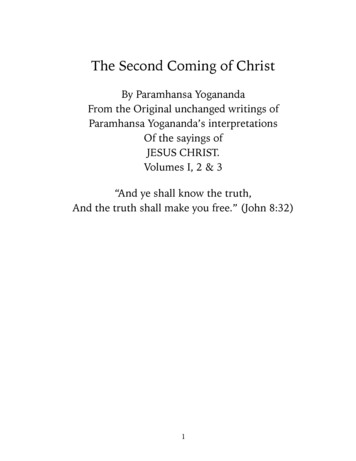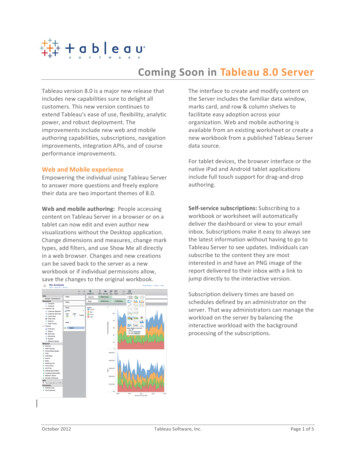
Transcription
Tax Policy BulletinMultilateral instrument coming intoforce to change many tax treatiesfrom 1 January 20191 4 May 2018In briefThe Multilateral Convention to Implement Tax Treaty Related Measures to Prevent BEPS (MLI) willenter into force on 1 July 2018, following Slovenia depositing the fifth ratification instrument on 22March 2018.Earlier, the following jurisdictions deposited their instruments of ratification with the OECD: Republic ofAustria, the Isle of Man, Jersey, and Poland.The entry into force of the MLI for double tax treaty Parties (as defined) determines when its provisionscome into effect for the treaties between them. Different dates potentially apply for withholding taxes,other taxes, mutual agreement procedures to resolve disputes, and the use of arbitration to resolvedisputes, where territories have chosen to apply arbitration.We ex pect a significant number of the current 78 signatories to ratify the MLI and lodge the instrumentof ratification with the OECD in time for many provisions to be in effect from 1 January 2019. Forbilateral treaties this broadly relates to: withholding tax events arising from 1 January 2019 where the parties have both fully ratified before 1October 2018 other taxes for accounting periods beginning on or after 1 January 2019 under the Austria-Slovenia,Austria-Poland and Slovenia-Poland treaties (or other treaties in the unlikely situation in which theparties fully ratify before 1 October 2018 and agree to 1 January 2019 rather than the agreed defaultperiod) mutual agreement procedures where the latest party to ratify does so in September 2018 (so it couldbe earlier than 1 January 2019 where both parties ratify before 1 September 2018), and arbitration cases, where both parties opt in and the latest party to ratify does so in September 2018 (soit could be earlier than 1 January 2019 where both parties ratify before 1 September 2018).Alternative effective dates will apply to many provisions and circumstances, and careful scrutiny will benecessary of the various defaults and options.www.pwc.com
Tax Policy BulletinThis Tax Policy Bulletin provides an overview of when and for which provisions the MLI will enter into effect in thebilateral tax treaties of the MLI signatories. The Bulletin also covers the - largely unforseen - consequences of territories’differing reservations regarding hybrid mismatches, treaty abuse, permanent establishments and dispute resolution.In detailBackgroundThe MLI covers recommendations from the base erosion and profit shifting (BEPS) project that affect double tax treaties.This applies both to various minimum standards and some additional recommendations. The MLI was developed underAction 15 and encompasses recommendations for: Action 2 (hybrid mismatches) Action 6 (treaty abuse) Action 7 (permanent establishments), and Action 1 4 (dispute resolution).On 7 June 2017, 68 territories signed the MLI and a further ten have signed it since then, making 78 signatories so far. Ofthese, five have now obtained the status of ratification territories - Republic of Austria (22 September 2017), the Isle ofMan (25 October 2017), Jersey (15 December 2017), Poland (23 January 2018) and Slovenia (22 March 2018) . Six furtherterritories have currently committed to sign.With the aid of our MLI tracker, we have estimated the number of existing treaties involving combinations of statusterritories as set out in the diagram below. Some of these are not ‘covered tax agreements’ (CTAs) within the MLI’s terms,i.e., they have not been listed by both parties for the purposes of the MLI, often because a new treaty is already beingnegotiated.Countries that were part of the post-BEPS discussions on the MLI but have not signed the MLI include the US, Brazil,Kazakhstan and Ukraine. Of these, only Kazakhstan to date has given a firm commitment to sign the MLI. The others,along with the remainder of the 113 country BEPS Inclusive Framework, will be expected to meet the BEPS minimumstandards in alternative ways (e.g., via bilateral agreement or protocol).There are some MLI provisions that MLI signatory territories are required to apply unless, again, they will meet thoseminimum standards in alternative ways. Some provisions are entirely optional. Other texts in the MLI provide choices of2pwc
Tax Policy Bulletinapproach. Territories have deposited with the OECD their draft ‘positions’ in these respects and must make them final onratification.The range of materials published by the OECD to help interpret the MLI was described in our Tax Policy Bulletin of 13June 2017.Entry into force and entry into effectEntry into forceNow that five territories have ratified the MLI and deposited with the OECD their instruments of ratification together witha statement of their final positions (‘ratification/ deposit’), the MLI has a date on which it will enter into force underArticle 34(1) of the MLI. That date is 1 July 2018.This date affects the potential timing for when the MLI will enter into effect in relation to a treaty to which one of thosefiv e movers is a Party. In practice it is determinative only in relation to the Austria -Slovenia, Austria-Poland and SloveniaPoland treaties. The other four treaties involving combinations of these territories are not CTAs. The interaction of theentry into force date and timing of when provisions take effect is set out below.The MLI will generally enter into force under Article 34(2) as regards any other territory three clear months from itsratification/ deposit by that territory.The diagram below shows the process of entry into force for the first five ratifiers and theoretical illustrations for State 6(say , ratification/ deposit between the date of this bulletin and 1 July 2018) and State 7 (say, ratification/ deposit after 1July 2018).Entry into effectThe effective dates from which the MLI provisions will modify the wording of a particular CTA differ according to thematter in point and options made by the Parties.The default dates are: Withholding taxes (WHT) - events from 1 January following the latest MLI entry into force date for the Parties (Article35(1)(a)) Other taxes - taxable/ accounting periods (APs) beginning from six months after the latest MLI entry into force date forthe Parties (Article 35(1)(b))3pwc
Tax Policy Bulletin Mutual agreement procedures (MAP) - eligible cases presented from the latest MLI entry into force date for the Parties(Article 35(4)), and Arbitration - cases presented from the latest MLI entry into force date for the Parties and cases presented prior to thatfrom the date mutually agreed by the Parties (Article 36(1)).The main (but not only) options available to MLI territories include the right to: asy mmetrically (i.e., for its own purposes only) have the WHT rules apply earlier, to events occurring from the latestMLI entry into force date for the Parties (Article 35(2)) asy mmetrically have the other taxes rules apply later, to APs beginning from the 1 January following six months afterthe latest MLI entry into force date for the Parties (Article 35(3)) - which Austria has done, as shown in the diagrambelow, and Jersey has also done sy mmetrically (i.e., if the parties to a CTA agree) have the other taxes rules apply sooner, to APs beginning from anagreed/ notified date after the latest MLI entry into force date for the Parties but before six months after that date(Article 35(1)(b)) restrict the application of MAP to WHT and other taxes within scope of the MLI, rather than by reference to the timethe case is presented (Article 35(6)) - which the Isle of Man and Jersey have done, and restrict the application of arbitration for existing cases to the extent the Parties mutually agree (Ar ticle 36(2)) - whichAustria and Slovenia have done, applying that proviso to the treaty between them as well as potentially in relation toother treaties to which they are parties (but not the treaties they have with Poland, as Poland has not opted into t hearbitration provisions).The diagram below shows the process of entry into effect for the Austria-Slovenia treaty and a theoretical illustration forAustria and another territory, State X (entry into force, say, on 1 September 2018) where State X chooses default MLI startdate options and opts into the arbitration provisions.After the MLI has entered into force for a territory, a territory can add extra CTAs or relax reservations (in whole or inpart) - territories may not strengthen or retract their reservations, meaning that in practice they can only move closer tothe BEPS 2017 Model Tax Convention, rather than away from it. There are special provisions to deal with these situations4pwc
Tax Policy Bulletinthat broadly replace the effective date for the changes to the entry into force date in the above calculations. Similarly thereare adjustments if a territory later opts in to the arbitration provisions, although the other party has a period of time toaccept the changes in relation to a particular CTA.Hybrid mismatchesBEPS Action 2 recommended best practices (not minimum standards) for the matters briefly set out below that could bepartly addressed by the MLI. Reference is made to the relevant article of the MLI and the equivalent article(s) of the OECDModel Tax Convention (MTC). The ability for a territory to opt-out (reserve) or make a relevant choice is also summarised.MLIModela rt i cleCommen tsOpt i onalityA rt 3 – Transparent entities1Den i es benefits where there is n o taxation of income due to transparencyCan reserve either orboth23A /23BLi m i ts dou ble tax reliefA rt 4 – Du al residenten ti ties4Repl aces effective m anagement tie-breaker with competent authorityagreementCan reserve outright ori n specificci rcumstancesA rt 5 – Application ofm eth ods for elimination ofdou bl e taxation23AA ddresses non -taxation arising from including the exemption method wherei n com e i s not taxed in the source state i n certain circumstances, by requ iringa tax credit to be given for tax imposed i n the other territory insteadCan reserve outright ori n specificci rcumstancesTo illustrate one of these by reference to a hypothetical example, consider the impact of MLI Article 4 (Dual residententities) on the structure below involving Australian entities dual resident also in another Territory Y (or otherTerritories). Australia is chosen here only because of the need to illustrate the position in relation to a given territoryand one whose residence rules could interact with those of other territories in ways that give rise to dual residencesituations.Using our MLI Tracker, we identify 15 Australian treaties in which MLI Art. 4 does not apply and 1 6 treaties in whichthe text of Paragraph 1 of Art. 4 applies with a different last sentence. Consider one, say Malta, from the displayed nonapplicable list and another, say the UK, from the applicable list. Australia’s draft positions lodged with the OECD notifyboth treaties as CTAs and, as required by MLI Art. 4(4), notify that Article 4(5) in the Malta treaty and Article 4(4) inthe UK treaty - similar to Article 4 in the OECD Model - contain an existing dual residence tie-breaker (as described inthe compatibility clause in MLI Art.4(2)), which it does not exclude by reservation from application of this MLI article.5pwc
Tax Policy Bulletin How ever, while Malta’s draft positions notify the Australia treaty as a CTA they reserve entirely against theapplication of this MLI article in relation to any of Malta’s CTAs.On the other hand, the UK’s draft positions notify the Australia treaty as a CTA and equally notify Article 4(4) ofthe Australia treaty as containing an existing dual residence tie-breaker which it does not exclude byreservation.One difference between Australia’s draft positions and the UK’s draft positions is the reference in the former toreplacement in the new tie-breaker of the final sentence. That substitution applies to deny any relief or exemption wherethe Competent Authorities cannot agree on the taxpayer’s residence (the default would otherwise have been to allow forthe possibility of the Competent Authorities providing a measure of relief or exemption). That applies irrespective of theUK being silent on the matter.So, the positions are summarised in our MLI Tracker in relation to MLI Art.4 as: Australia-Malta treaty: No changes to existing treatyAustralia-UK treaty: “Art. 4(4) of existing treaty is replaced by Art. 4(1) of the MLI (with last sentence of Art.4(1 ) replaced by text described in Art. 4(3)(e) of the MLI)”.Treaty abuseBreadth of treaty abuse recommendations in MLIBEPS Action 6 set out to address what it referred to as situations in which “Taxpayers engaged in treaty shopping andother treaty abuse strategies undermine tax sovereignty by claiming treaty benefits in situations where these benefits werenot intended to be granted, thereby depriving countries of tax revenues”. It recommended new treaty anti-abuse rules thatprovide safeguards against the abuse of treaty provisions (but offer a certain degree of flexibility regarding how to do so).These cover not only treaty shopping, which involves strategies through which a person who is not a resident of a Stateattempts to obtain benefits that a tax treaty concluded by that State grants t o residents of that State, but also the moreunderlying purpose of treaties and some specific transactions or structures. Before looking at the Principal Purpose Test(PPT) and Limitation on Benefits (LoB) tests - including the simplified LOB, or S-LOB, and detailed LOB - the table belowprovides a brief summary of the v arious MLI Articles targeted at treaty abuse:6MLIModela rt i cleCommen tsOpt i onalityA rt 6 – Purpose of a tax treatyPreambleCl arifies that tax treaties are not intended to createopportu nities for double non-taxation through evasion orav oi danceBEPS m inimum standard, butcan reserve if existingequ i v alent wordingA rt 7 – Prevention of treaty abuseN /AProv ides an anti-avoi dance rule or PPT, optional addition alS-LOB test (and suggests territories indicate if they intend tom ov e toward a detailed LOB test)BEPS m inimum standard, butsom e opti on ality (see furtherbel ow)A rt 8 – Di vidend transfertransactions10A dds a minimum h olding period of 365 days to anyown ership tests in dividend WHT articlesCan reserve outright or whereexi sting minimum holdingperi odA rt 9 – Capital gains from alienationof sh ares deriving v alue principallyfrom i mmovable property13In troduces a 365 day period for testing whether an entity wasdi rectly or i ndirectly land-rich (i.e. apply test con tinuouslyth rou ghou t the year)Can reserve outright or inspeci fic circumstancespwc
Tax Policy BulletinA rt 10 – Anti-abuse where low taxedPE i n third territoryN /ADi scretionary denial of treaty benefits where income earnedby exempt branch taxed at 60% of Head Office tax rateCan reserve outright or inspeci fic circumstancesA rt 11 – Application of treaties torestrict a territory’s right to tax i tsown residentsN /AIn serts a ‘savings clause’ con firming that a treaty does n otrestrict a territory’s right to tax i ts own residents, other thani n specified circumstances (e.g. corresponding adjustments)Can reserve outright or whereexi sting provision sScope of the PPT, S-LOB and LOBOf the treaty abuse rules, Article 7 has drawn the greatest interest. In regard to a minimum standard on anti-treatyshopping, the BEPS report recommended three options (or equivalent restrictions): the PPT the PPT with a S-LOB, or a detailed LOB with either an anti-conduit rule or a purpose test.The PPT applies by default under the MLI (under Article 7(1)) and territories can reserve against it (under Article 7(15)(a))only in certain circumstances in which they will otherwise meet the minimum standard. Where a benefit would be deniedunder the PPT, a territory can opt in to grant the benefit or a different benefit that would have been granted to anapplicant taxpayer in the absence of the transaction or arrangement (under Article 7(4), and after consultin g with theCompetent Authority of the other Party to the CTA).The current MLI signatory/ ratification territories have all chosen to apply in CTAs one of the first two options eachinv olving the PPT, rather than reserving in favour of a detailed LOB. However, of these, Canada, Chile, Colombia, Kuwait,Mauritius, Norway, Poland, Senegal, and Seychelles have indicated an intention, in time, to adopt a detailed LOB inaddition to or instead of the PPT. Further, our MLI Tracker indicates that, notwithstanding territories’ overall choices,there are 15 CTAs in relation to which the PPT does not apply despite it being a minimum standard to adopt one of thethree routes - a territory can reserve the right for existing treaty provisions to continue on the basis tha t they are alreadysufficiently robust (Article 7 (15)(b), e.g., Germany’s draft positions make this reservation and notify provisions in thetreaties with China, Israel, Japan and Mauritius where it believes this is the case).To illustrate this by reference to a hypothetical example, consider the impact of the MLI PPT on the structure belowinvolving a Luxembourg holding and finance company with a number of operating companies in the US and the EU,with permanent establishments (PEs) in Greece and Denmark.The PPT w ill not have a direct impact on the US operating company since the US has not signed the MLI.7pwc
Tax Policy BulletinThe PPT w ould not (on the basis of draft positions) have a direct impact on the Senegal operating company. Senegal hassigned the MLI and generally chosen to adopt the PPT and S-LOB pending negotiation of a detailed LOB. However, ithas reserved against the application of the PPT in relation to the CTA with Luxembourg on the basis that the existingtreaty between them contains a sufficiently robust purpose test already. Luxembourg does not choose generally to applythe S-LOB, nor does it apply additional options to allow the S-LOB symmetrically or asymmetrically in thesemismatched cases - so the S-LOB does not apply at all to the Luxembourg-Senegal CTA.Within the EU, the Luxembourg-Estonia treaty is not yet relevant as Estonia is only committed to signing the MLI andhas not yet done so, while Luxembourg does not have a treaty w ith Cyprus.As regards the EU operating companies, our MLI Tracker also shows that Luxembourg’s CTAs with 8 EU MemberStates include the additional discretionary element when a taxpayer fails the PPT while the other 17 Member Statesapply the PPT w ithout it. Of the EU Member States, Luxembourg only notifies its treaty with the UK as having anexisting purpose test in Article X(3)(d), which will then be replaced by the PPT; in other cases, the PPT (anddiscretionary benefits) provisions supersede the CTA’s provisions, though the wording strictly states “to the extent thatthose provisions are incompatible with the existing text” (under Article 7(17)(a)). Further, Bulgaria and Slovakia havechosen to apply the S-LOB, but as noted above, since Luxembourg does not choose the S-LOB nor apply additionaloptions to allow the S-LOB symmetrically or asymmetrically in these mismatched cases, the S-LOB does not apply to theCTAs Luxembourg has with those Member States.However, for the PEs, Denmark’s draft positions show that while it doesn’t want to apply the S-LOB generally, where aParty with w hich it has a CTA chooses to apply the S-LOB, Denmark w ill also apply it for purposes of that CTA (underArticle 7 (7)(a)) - so if the head office of the Denmark PE is in Bulgaria or Slovakia, the CTAs it has with those MemberStates would apply the S-LOB as well as the PPT. On the other hand, Greece’s draft positions show that it opts in toallow a Party w ith which it has a CTA to apply the S-LOB asymmetrically - only to its own residents (under Article7 (7)(b)) - so if the head office of the Greek PE were to be in Bulgaria or Slovakia, those Member
Art 3 – Transparent entities 1 23A/23B Denies benefits where there is no taxation of income due to transparency Limits double tax relief Can reserve either or both Art 4 – Dual resident entities 4 Replaces effective management tie-breaker with competent authority agreement Can reserve outrigh









![Coming Soon! [ abctxgulfcoast ]](/img/12/08-2016coastline.jpg)

